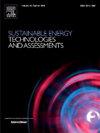Thermal and enviro-economic analysis of solar stills: Influence of fin geometry, size, and water depth
IF 7.1
2区 工程技术
Q1 ENERGY & FUELS
Sustainable Energy Technologies and Assessments
Pub Date : 2025-04-24
DOI:10.1016/j.seta.2025.104335
引用次数: 0
Abstract
Solar distillation is a promising technology for producing fresh water in remote and arid regions, leveraging renewable solar energy to drive evaporation and condensation processes. However, conventional solar stills often suffer from low efficiency due to limited heat transfer. This study investigates the enhancement of solar still performance through the integration of circular and triangular fins on the absorber plate, a novel approach aimed at maximizing heat absorption and improving evaporation rates. Experimental tests were conducted under the climatic conditions of Bhopal, India, to evaluate the effects of fin geometry on water productivity. The experiment was performed at three different water depths (15, 30 and 45 mm). The results demonstrate that the circular fins gives maximum yield of 1.4 L/day, while triangular fins gives 0.95 L/day. The maximum evaporative heat transfer coefficient was found 20.8 W/m2K at water depth of 15 mm in case of circular fin. The energy payback time (EPBT) was 1.29 years for circular fins and 1.99 years for triangular fins. The study provides a comparative analysis of fin performance, offering new insights into optimizing heat transfer mechanisms for more efficient solar distillation systems.
太阳能蒸馏器的热与环境经济分析:翅片几何形状、尺寸和水深的影响
太阳能蒸馏是一项很有前途的技术,用于在偏远和干旱地区生产淡水,利用可再生太阳能驱动蒸发和冷凝过程。然而,传统的太阳能蒸馏器由于传热有限,效率往往较低。本研究探讨了通过在吸收板上集成圆形和三角形翅片来增强太阳能蒸馏器的性能,这是一种旨在最大化吸热和提高蒸发速率的新方法。在印度博帕尔的气候条件下进行了实验测试,以评估鳍形对水生产力的影响。实验在三种不同的水深(15、30和45 mm)下进行。结果表明,圆形翅片最大产率为1.4 L/d,三角形翅片最大产率为0.95 L/d。在水深15 mm处,圆翅片的蒸发换热系数最大,为20.8 W/m2K,能量回收期(EPBT)为1.29年,三角翅片为1.99年。该研究提供了翅片性能的比较分析,为优化更高效的太阳能蒸馏系统的传热机制提供了新的见解。
本文章由计算机程序翻译,如有差异,请以英文原文为准。
求助全文
约1分钟内获得全文
求助全文
来源期刊

Sustainable Energy Technologies and Assessments
Energy-Renewable Energy, Sustainability and the Environment
CiteScore
12.70
自引率
12.50%
发文量
1091
期刊介绍:
Encouraging a transition to a sustainable energy future is imperative for our world. Technologies that enable this shift in various sectors like transportation, heating, and power systems are of utmost importance. Sustainable Energy Technologies and Assessments welcomes papers focusing on a range of aspects and levels of technological advancements in energy generation and utilization. The aim is to reduce the negative environmental impact associated with energy production and consumption, spanning from laboratory experiments to real-world applications in the commercial sector.
 求助内容:
求助内容: 应助结果提醒方式:
应助结果提醒方式:


